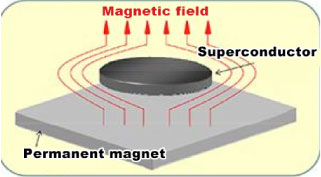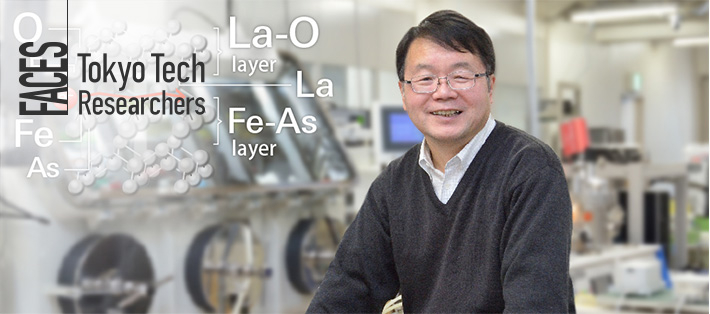
Special ReportPart 1
ProfessorHideo Hosono
Frontier Research Center Director
Materials Research Center for Element Strategy
For his discovery of iron-based superconductors in 2008, Professor Hideo Hosono was selected as a Thomson Reuters[1] Citation Laureate in 2013 and became a leading contender for the Nobel Prize. His passion for materials research knows no bounds; even now he is continuing the search for new functional materials. Professor Hosono doesn't just operate at the leading edge of research on iron-based superconductors. A transparent oxide semiconductor IGZO, which is attracting attention and is widely used to drive displays of smart phones and tablet PCs, is also a result of Professor Hosono's research. Moreover, in catalyst research he has been trying to change the ammonia synthesis process which has remained unaltered for approximately a hundred years. How is it that Professor Hosono has been able to undertake research in such diverse fields and achieve major results in each of them? In this and an upcoming, second article, we will present Professor Hosono's achievements and the research style that made them possible.
A magnet becomes a superconductor?
The first new high-temperature superconductor discovered in 20 years
The research that is most representative of you and your work is the discovery of
iron-based superconductors[2] correct? This discovery is highly regarded,
and is the reason Reuters named you a leading candidate for the Nobel Prize.
In 2008 my research group announced that we had discovered an iron-based superconductor: a high-temperature superconductor that contains iron as its main constituent. The reason this discovery had an impact is that it overturned the commonly held view that elements like iron, with a large magnetic moment, must be inimical to the manifestation of superconductivity (see photograph below, left). Consequently, this discovery had an impact on the world of superconductivity.
A superconductor is floating above a permanent magnet. This is called the Meissner effect. When a magnetic field is applied to a superconductor, the magnetic flux will not penetrate the superconductor as long as the magnetic field does not exceed a certain strength. This phenomenon is characteristic of superconductors (see drawing below, right). It has thus been thought that materials containing iron, which easily become magnetized, could not become superconductors.
Would you say that this impact rekindled superconductivity research worldwide?
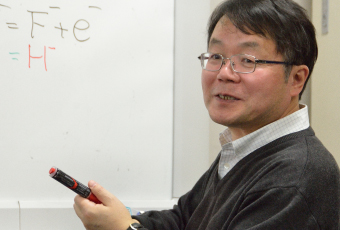
That seems to be the case. Regarding superconductivity, the discovery of a cuprate superconductor by Georg Bednorz and Alex Müller in 1986 was truly an event. When they doped the carriers (holes) in an oxide of copper, which normally conducts almost no electricity, it became a superconductor. Moreover, the superconducting transition temperature (the temperature at which a material becomes a superconductor) was -238℃. This was much higher than the superconducting transition temperatures of the other metal and alloy superconductors known at the time. This high-temperature superconductor was startling. It turned the world upside down.
In superconductivity research even today, many researchers are frantically searching for some material that will become superconductive at a higher temperature. With such a material it would then be possible to create such things as maglev (magnetic levitation) trains and power transmission wires with almost no energy loss. But superconductivity does not occur unless the temperature is extremely low, which has so far prevented putting superconductors to practical use.
Moreover, in the 2000s, the rise in the superconducting transition temperature of cuprate superconductors hit a ceiling. Superconductivity researchers concluded that new efforts based on new materials were necessary. That is where our iron-based superconductor enters the picture. As a result, research seeking new materials with a high superconducting transition temperature once again heated up worldwide. It was against this background that our first paper in 2008 in which we reported the discovery of an iron-based superconductor had the highest number of citations in the world for that year. And it continues to be cited today: as of May 2014, it has been cited over 5,000 times (Google Scholar ).
).
Did this major achievement result from long years of superconductivity research?
No. There were many people around me who began superconductivity research in response to the discovery of cuprate superconductors in 1986. However, I did not get involved. That was because I did not see how I could beat the competition. What makes it possible to prevail in research, I believe, is achieving originality at a global level. I won't undertake research if its originality is not clear from the start.
However, in 2007 I found that, as I had anticipated, a cement material (C12A7, see the second article), which I had researched for many years, could become a superconductor. Contrary to my expectation, the superconducting transition temperature was low. But this research stimulated me to undertake superconductivity research. Interestingly, though, it was not in this belatedly begun superconductivity research that I discovered the iron-based semiconductor.
Actually, besides superconductivity research, I was also doing research on imparting magnetic properties to semiconductors.[3] In creating semiconductors endowed with new properties, I was trying to discover possibilities for new uses of oxide semiconductors. For example, oxide semiconductors can be used both for semiconductor memory and magnetic memory, and for operational circuits and magnetic memory. It was in the course of this research that I was able to discover the iron-based superconductor.
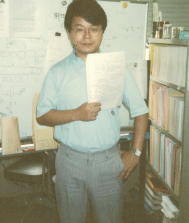
Professor Hosono, 1986
"Transparent materials" cultivated the eye of a researcher
While many researchers were just beginning superconductivity research, I felt I should continue research on transparent materials (to be discussed in the second article), which I greatly liked. I researched them for many years, obsessed with their transparency. The reason I abandoned this obsession is that I began research aimed at imparting magnetism to semiconductors. To impart magnetism to a material, the material must contain a transition metal that has spin, such as iron or cobalt. But materials that contain such metals are not transparent. Transparent materials are similar not just in appearance, but also have many properties and electron states in common. By having researched such materials for many years, I feel that I was able to cultivate an eye for looking at materials.
For imparting magnetism to a semiconductor, I selected layered compounds containing a transition metal that has a large magnetic moment, such as iron, to serve as the target material. Among such compounds, I investigated an oxypnictide compound (LaOFeAs) whose main constituent is iron. However, I was unable to obtain the desired properties with this material. Of course, it was not a superconductor. So I decided to try to change its electrical properties by using a technique for replacing the oxygen ions in LaOFeAs with fluorine ions (see Column 1). Doping carriers by substituting ions of a similar size but of a different valence is a common technique in semiconductor research. And when I did that, LaOFeAs became a superconductor. This was the 2008 discovery of an iron-based superconductor.
Column 1: The iron-based superconductor that Professor Hosono discovered
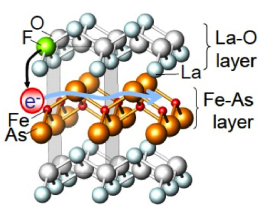
Ordinarily, electricity flows through a metal (for example, iron) but not through a metal oxide (ferric oxide). Moreover, it was commonly believed that metals like iron, which have the ability to become magnets, would not become superconductors. However, the iron-based superconductor which Professor Hosono discovered in 2008 is a pnictide (P or As) containing iron. Why was a pnictide containing iron able to become a superconductor?
It was because Professor Hosono achieved both a structure in which the electrons could move (electricity could flow) even in the presence of oxygen, and a chemical constituent that eliminates the magnetism of iron (see drawing).
The true identity of the iron-based superconductor is LaOFeAs, an oxypnictide compound whose main constituent is iron. This compound has a structure with alternating layers of LaO and FeAs. With this structure, however, electrical resistance does not become zero (the compound does not become a superconductor) even if the temperature is lowered. Therefore, Professor Hosono thought of changing the electrical properties by electron doping. Electron doping consists of injecting electrons into the interior of a material. In the case of LaOFeAs, some of its oxygen ions (O2−) are replaced with fluorine ions (F−). Each time one oxygen ion is replaced with one fluorine ion, the result is that the material becomes doped with electrons. The electrons that are injected flow over the FeAs layer, and enhance the conductivity of the FeAs layer and diminish the antiferromagnetism. When the temperature becomes low, they create a state of superconductivity with zero electrical resistance and perfect diamagnetism. Thus, an iron-based superconductor is born.
It's said that you discovered the iron-based superconductor by chance, but can it not be said that you intentionally created it through the technique of ionic substitution?
It bears a strong resemblance to the discovery of a cuprate superconductor by Bednorz and Müller. To be exact, they discovered superconductivity in hole-doped cuprates and we discovered it in electron-doped LaOFeAs. The results of superconductivity research are not limited to what you plan, but it's important to build your predictions, and to proceed, based on theory. If you proceed at random, without forethought, you won't discover any superconductors. You have to think thoroughly and then attack with all your might. But even then, in the end, you won't find that groundbreaking superconductor if you don't have luck; this is the consensus view of experts in the field.
Also, from that experience I came to believe that, besides your core research, it's important to conduct research that covers the area around it, if you hope to be able to discover superior new materials.
Six years have passed since the discovery. Superconductor research has come quite a long way since then, wouldn't you say?
The importance of iron-based superconductors has been recognized. I obtained the opportunity to conduct research on the "Exploration of new superconductors and related functional materials and application of superconducting wires for industry" from 2009 to 2013, as part of a large, government-funded project (FIRST: Funding Program for World-Leading Innovative R&D on Science and Technology). I created a top team of Japan's ace researchers for this project. We sought to discover new superconductors and also conducted research on raising the superconducting transition temperature. Regarding the former objective, we synthesized approximately 1,000 candidate substances, among which we discovered 25 superconducting materials (about 70 chemical compounds). This is a success rate of 2.5 percent. What do you think when you hear that number? Does it seem low? Actually, in the world of superconductivity research professionals, it's considered high.
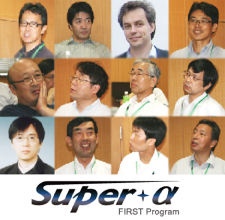
FIRST research colleagues
Don't fear loneliness
Original research is lonely work, so I think being able to endure loneliness is a prerequisite for producing original results. Even in FIRST I limited the opportunities for members to learn about what the others were doing in their respective research to one general meeting every six months. I think I was able to maintain a good feeling of tension among the members. Of course, at the general meetings they totally disclosed their research to each other and discussed strenuously to promote everyone's overall progress. When you want to do something original, you can't be afraid of loneliness. Because originality is truly something achieved alone.

At the same time, we conducted research on raising the superconductor transition temperature of the iron-based superconductor we had initially discovered.
Instead of replacing LaFeAsO's oxygen ions with fluorine ions, as we had been doing until then, I thought of replacing them with negative hydrogen ions
(H-). This is an approach that I successfully applied to a cement compound, C12A7 (12CaO·7Al2O3), in 2002. By doing this, I expected to be able to dope more electrons than by replacing them with fluorine ions, and thus raise the superconducting transition temperature. In the end, we were able, as planned, to more than double the previous concentration of electrons in the doped material. But this did not have as great an effect as expected on the superconducting transition temperature.
However, the use of negative hydrogen ions was linked to an unanticipated discovery. That is, we discovered a new region that displays superconductivity (I decided to call it SC-2) which cannot be seen when replacing electrons with fluorine ions (see Column 2). We doped carriers into a parent material that possessed magnetism, and when the magnetism disappeared, superconductivity appeared. Until now, there was agreement that ferrous materials can be used as a parent material in a state where they are not doped with carriers; but in this research we ascertained that a parent material can also be in a state massively doped with carriers. That is, we understood that there exist two parent materials. This is currently attracting attention, in various places, as a finding that will lead to new developments in superconductivity research. I don't know what kinds of developments await, but we are now in a situation where 'around every corner there is another corner waiting to be turned.' Iron-based superconductor research is going to get even more interesting from here on out!
Hydrogen ions and the "Hosono-style periodic table"
Hydrogen usually becomes positive ions, but actually it can also become negative ions. I noticed this when I was doing research on changing the electrical properties of the cement material C12A7 (to be discussed in the second article). I thought that someday I would be able to use negative ions of hydrogen (H-). And, indeed, I eventually used them for injecting electrons into LaOFeAs.
Hydrogen appears at the top left of the regular periodic table. But in my periodic table it is placed in the top middle, because it becomes both positive and negative, depending on the circumstances.
With regard to SC-2, we wouldn't have been able to discover it if we hadn't had the idea of trying to use negative ions of hydrogen. I take pride in the fact that this discovery was something that only we could have done. After this region became known, some people said various things, such as, "There must be other domes, too, don't you think?" [Laughter]. Maybe there are. Perhaps the hard part is only beginning.
Column 2: The discovery of a new superconductor mechanism

The graph, or phase diagram, shows the extent of ion substitution and the relationship of this to superconducting critical temperature. Electrons were injected which increased the electron concentration in the oxypnictide compound (LaFeAsO) where the main constituent is iron. In the graph, in the gray dome on the left, oxygen ions were replaced with fluorine ions; in the pink dome on the right, oxygen ions were replaced with negative hydrogen ions.
Looking at the gray dome on the left side of the phase diagram, it is apparent that when oxygen ions were replaced with fluorine ions, electrons could only be injected up to a concentration of about 15 percent. This is because the oxygen cannot be replaced with fluorine to any greater extent. It was thus impossible to know what happened on the right side of the phase diagram. Professor Hosono reflected, "With such little information, it's impossible to meaningfully discuss superconductivity." But when oxygen ions (O2-) were replaced with negative hydrogen ions (H-), it was possible to inject ions to a concentration of more than 50 percent, and he discovered that there is a second dome, the pink one on the right side of the phase diagram. Why this came about in this way remains to be explained.
In the second of this two-article series, Professor Hosono discusses transparent oxide semiconductors, including IGZO, which some call his first major achievement. The first catalyst with which he grappled, which was an ammonia synthesis catalyst, is also discussed.
Explanations of Technical Terms
1. Thomson Reuters
A global information services company headquartered in the United States. Each year before the Nobel Prize announcements, Thomson Reuters announces its Citation Laureates (researchers who are considered leading contenders for the Nobel Prize on the basis of the number of citations of their published works). It is often thought that people who receive this award are likely to win the Nobel Prize too.
2. Superconductivity
This is a phenomenon of zero electrical resistance and perfect diamagnetism (the expulsion of all magnetic lines of force) that occurs in certain materials when they are cooled to a characteristic temperature. These materials are called superconductors.
3. Semiconductor
Materials can be classified by the ease with which electricity flows through them. There are "conductors," like metals, which readily conduct electricity; "insulators," which do not conduct electricity; and "semiconductors," which have an intentionally controllable conductivity level between that of conductors and insulators. Semiconductors are neither conductors nor insulators, but the ease with which electricity flows in them can be controlled by design, so they are used as a material in electronic equipment such as transistors.
The Special Topics component of the Tokyo Tech Website shines a spotlight on recent developments in research and education, achievements of its community members, and special events and news from the Institute.
Past features can be viewed in the Special Topics Gallery.
. Any information published on this site will be valid in relation to Science Tokyo.






